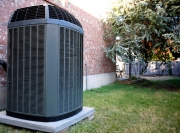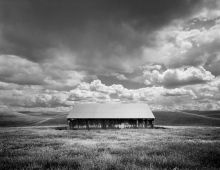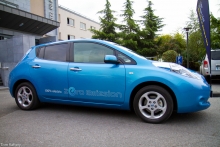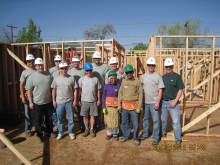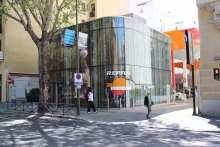- Error
{Re}habitat
Learn how adaptive reuse and upcycling can add hip design to your home, apartment, or yard with the Go Green channel's {Re}habitat series. Follow host Rachael Ranney as she shows you how to repurpose salvaged and found materials, adding fun and function to your space without breaking your budget.

Perform a few simple maintenance tasks, schedule professional HVAC service on a yearly basis, and enjoy efficient performance and trouble-free operation of your central air conditioner throughout its expected lifespan (and maybe longer).
Invented after the turn of the 20th century but not mass-produced for homes until after World War II, the air conditioner has increased our comfort and modified the landscape from coast to coast. According to the U.S. Department of Housing and Urban Development (HUD) 2009 American Housing Survey (AHS), 75% of owner-occupied housing in the United States has a central air conditioning unit. The average life expectancy of these air conditioning units is 10–15 years, according to the Study of Life Expectancy of Home Components, prepared in 2007 by the National Association of Home Builders (NAHB). Neglecting your unit will result in a shortened lifetime, costly repairs, and higher energy costs due to inefficient operation. Maintain your unit and you will extend its lifetime and keep repair and energy costs low while ensuring your comfort on those hot summer days.
John McAslan + Partners created a canopied addition to the historic King's Cross Station, leaving the original western facade intact.
Heralded for its historical importance but rather drab, London’s King's Cross Station recently underwent a multimillion dollar redevelopment, reopening to the public on March 19, 2012. The newly overhauled King’s Cross Station was lit up in celebratory bright colors, creating a concert-like atmosphere – appropriate to its new youthful vibe. It was a timely redevelopment, as the XXX Olympic Summer Games will be held in London in 2012. The station’s western concourse, at 7,500 m2, is Europe’s largest single-span station structure. Each year 45 million people pass through King’s Cross Station, and that number is predicted to rise by 10 million by 2020.
Bay Area architect David Stark Wilson, founder of WA Design, published a collection of photographs that highlights the vernacular architecture of California’s Central Valley and the foothills of the Sierra Nevada.
Structures of Utility, published by Heyday Books, breaks with the traditional coffee table photography book layout and instead feels more like an architectural monograph. David Stark Wilson supplements his black and white photographs with concise text that places his subjects within a historical context, layered with his personal memories and experiences.
Electric vehicles provide a welcome alternative to gasoline-powered cars ... welcome, that is, as long as we are still able to fuel up as we travel. Take a look at current options available in the United States for charging while on the go.
When Eddy Grant came up with the lyrics to his 1982 hit “Electric Avenue” he likely wasn’t expecting people to actually be rocking down an electric highway just 30 years later. That's what people will be doing later this year on the West Coast Electric Highway (WCEH), a tri-state initiative that will form the longest electric vehicle (EV) charging network in the country, stretching along Interstate 5 from the Canadian to the Mexican border.
BIM Helps Habitat for Humanity Partner Family Take a Virtual Tour of Their New Home
Written by Kristin Dispenza Fri May 04 2012By implementing BIM, Habitat for Humanity of Metro Denver found a way to shorten construction schedules as well as to achieve better communication with volunteers and partner families.
BIM improves efficiency and thereby improves the bottom line: Companies that were early adopters of BIM have been educating us on this fact for several years. What may not be as immediately apparent is that improving efficiency can sometimes improve more than just the bottom line. When non-profits implement new technologies with the result of achieving greater efficiencies, it can enable them to improve the lives of more people -- and do so more quickly -- than was ever before possible.
One of the most common worries among parents is that their children will fall on the stairs. In addition to installing gates and other protective devices, addressing any issues with the structure of the stairs themselves – especially the flooring around the stairway – can prevent injury.
A study published in March 2012 in the medical journal Pediatrics found that an estimated 932,000 children under the age of five were taken to hospitals for injuries received while falling down stairs between 1999 and 2008. In the subgroup of babies age one year or less, 25% were being carried by an adult at the time of the fall. As a homeowner, you should be aware of certain things to ensure that the stairs in your home are safe for you and your family.
Gas station design is about to experience a major shift. Madrid’s BREEAM-certified Repsol station demonstrates what may be on the horizon, both in terms of building design and what is for sale at the pump.
For most, gas stations may not come to mind when talking about exceptional green design, especially these days. Gas prices are continuously soaring, and we are more commonly wide-eyed at the outrageous prices than at the eco-friendly qualities or pleasing aesthetics of these in-and-out petrol ports.
Titanic Signature Project: An Exploration of Belfast's Shipbuilding Past
Written by J. Mariah Brown Tue May 01 2012A new exhibition center in Belfast tells the story not only of the Titanic but of the long maritime history of this iconic city.
One hundred years after the RMS Titanic’s maiden voyage and tragic sinking, visitors of the Titanic Signature Project in Belfast, UK, will be able to delve deep into the story of the Titanic and Belfast’s rich ship-building history. The five-level, 12,000 sq. m. (129,166 sq. ft.) building features a glass-walled atrium, which leads visitors to various exhibits throughout the building. The lofty space with irregularly angled forms provides the perfect introduction for the displays that follow.
